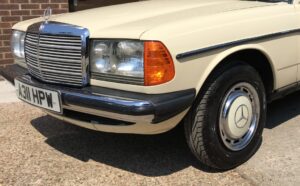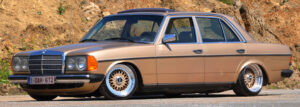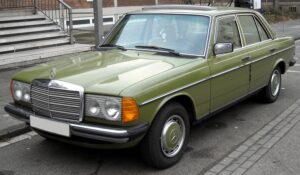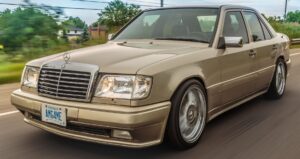All about Mercedes W123
3. How much does a Mercedes W123 cost?
Mercedes W123 wheels
All about Mercedes W123. The Mercedes W123 model, manufactured from 1976 to 1986, typically came equipped with 14-inch wheels as the standard size. These wheels were often steel rims with hubcaps, reflecting the design aesthetics of that era. The specific wheel design could vary based on the trim level and model variant.
Moreover, Mercedes offered optional alloy wheels for some versions of the W123, especially those with sportier trims. Alloy wheels not only provided a different look but also offered potential benefits such as reduced weight and enhanced heat dissipation.
It’s worth noting that the availability of specific wheel options might also depend on the market and the customer’s preferences when purchasing the vehicle.
How many W123 were made
Mercedes produced approximately 2.7 million units of the W123 series during its production span from 1976 to 1986. The W123 was a versatile line, featuring various body styles, including sedans, estates, and coupes. Its robust engineering, advanced safety features for its time, and timeless design contributed to its widespread appeal.
The production figures highlight the model’s success and acceptance in the automotive market. The W123 is often celebrated for its reputation as a workhorse, known for its longevity and reliability. The diverse range of engines, including diesel options, further expanded its market reach, making it a popular choice for a broad spectrum of drivers around the world. The enduring legacy of the W123 is reflected in the number of units produced and its enduring presence in classic car circles.
How much does a Mercedes W123 cost?
Keep in mind that these are general price ranges and actual prices can vary based on factors such as the car’s condition, mileage, maintenance history, and any modifications. Additionally, market conditions and location can influence prices.
Needs Restoration:
Starting from a few hundred euros to around 2,000 euros.
Average Condition:
Typically between 2,000 euros to 7,000 euros.
Well-Maintained or Restored Models:
Between 7,000 euros to 15,000 euros or more, depending on factors like mileage, condition, and any unique features.
Exceptional or Collectible Models:
Rare models, limited editions, or those in exceptional condition can surpass 15,000 euros and may even go well beyond, especially for certain sought-after versions.
These ranges are meant to provide a general overview, and actual prices can fall outside of these brackets. It’s advisable to thoroughly inspect any used car, check its maintenance history, and consider having a pre-purchase inspection performed by a qualified mechanic. Additionally, market conditions and demand can affect pricing, so it’s a good idea to check local listings and classifieds for the most accurate and current information.
Mercedes W123 vs W124
The Mercedes W123 and W124 are both part of the E-Class series, representing different generations of Mercedes-Benz sedans. Here’s a more detailed comparison:
Mercedes W123:
Production Years: 1976–1986.
- Design and Styling: The W123 is known for its classic, angular design, representing the styling of its era. It was available in various body styles, including sedan, coupe, and estate.
- Technology: While innovative for its time, the technology in the W123 is more basic compared to modern standards. It features classic Mercedes engineering with a focus on durability and reliability.
- Safety Features: Safety features were relatively basic compared to contemporary standards.
Mercedes W124:
Production Years: 1985–1996.
- Design and Styling: The W124 introduced a more aerodynamic and modern design compared to the W123. It was available in similar body styles, including sedan, coupe, and estate.
- Technology: The W124 showcased advancements in technology, including improved suspension, more sophisticated electronics, and modernized interior features. It was a step forward in terms of comfort and driving dynamics.
- Safety Features: The W124 incorporated enhanced safety features compared to its predecessor, including airbags and improved crumple zones.
Comparison:
- The W124 is generally considered a more refined and technologically advanced model compared to the W123.
- The W124’s design is more aerodynamic, reflecting the evolution in automotive styling trends.
- Both models are appreciated for their build quality and durability, but the W124 is often seen as a more modern and comfortable vehicle.
- Collectors and enthusiasts value both models, with the W123 being celebrated for its classic charm, and the W124 for its more sophisticated features.
Ultimately, the choice between the W123 and W124 depends on individual preferences, budget, and whether one prioritizes a classic, vintage aesthetic (W123) or a more modern and refined driving experience (W124).
Are you already a proud owner of a Mercedes W123? If so, check out our selection of parts for this car at the following link:
https://octoclassic.com/product-category/mercedes-benz/w123
Photos sources: bridgeclassiccars.co.uk, jdmeuro.com, Reddit, commons.wikimedia.org











